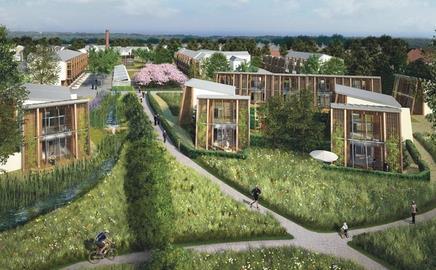It’s all very well building super-efficient eco villages, says Ross Holleron of Inbuilt, but we mustn’t ignore the existing homes and amenities that surround them
The Hanham Hall eco-village in Gloucestershire reached level six of the Code for Sustainable Homes, yet it is predicted that it will produce excess heat from its combined heat and power system in summer months. Some of this will supply the hall and a communal glass house, but the rest will have to be dumped. Ideally this energy would have been used more productively, for example to heat surrounding homes. The question is, why are we not doing this?
One reason is that we are still not thinking creatively enough about the refurbishment of existing stock. Improving the thermal performance of existing properties has to be our starting point, but this can be hard to achieve as many inefficient homes are deeply loved by their occupants. There are limits to how much people are prepared to alter the fabric of these buildings – and on how much we can squander our architectural heritage.
As such, our target should be to decarbonise the energy they use – and this is the link between how we treat new and old buildings.
At the moment, the industry seems to think of new build and refurbishment as entirely separate. Only recently has attention been paid to how new-build programmes might cross-fund improvements to existing stock, something that will ultimately benefit both markets.
There are some mechanisms that are already in place, for example, section106 agreements have been expanded to allow refurbishment work and the community infrastructure levy, which will replace some section 106 agreements next year, could be used to divert funds into district heating systems.
Another idea being discussed is that on more difficult new-build sites, where reaching code level six is not viable, developers would be allowed to build to a more achievable level (for example, zero emissions from space heating, hot water, ventilation and lighting only), and invest the savings into an independently managed community energy fund. This funding source could help support district-scale refurbishment and the expansion of low-carbon community energy networks from within new-build developments to surrounding buildings.
The Milton Keynes carbon roof tax model shows another way of doing things. Money raised from taxing the carbon emissions of new developments is being spent on upgrading existing homes. Developers pay into a fund according to the additional carbon emissions generated by their buildings in return for planning permission. In a very short time more than £250,000 has been raised this way.
Whatever the funding mechanism, successful refurbishment strategies can be identified by thinking more widely and by combining the most effective technical solution with strong and effective participation of local residents.
It is crucial to work in an integrated way with all groups using local plans, agreements and partnerships to ensure all opportunities are taken to link old and new schemes together. Into this mix also goes early community consultation, a cohort of designers and technical experts working as one and everyone engaged and committed to clear targets and vigorous management of the decision process.
On completion, extensive feedback consultation ensures the project aims have been met and that lessons are learned for future projects. Ultimately, real environmental, social and economic progress demands a more integrated approach. Look for the links, and you may find the key to achieving genuine sustainability.
Postscript
Ross Holleron is a principal consultant at Inbuilt





























No comments yet